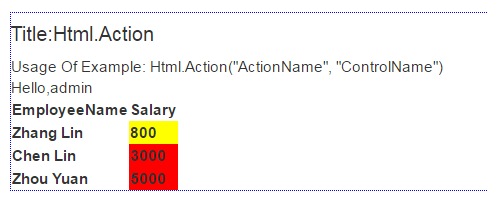1. @Html.Raw() 方法输出带有html标签的字符串:


<div style="margin:10px 0px 0px;border:1px;border-color:red;border-style:dotted;"> <h4>Title:Html.Raw</h4> Html.Raw:@Html.Raw("<div style=\'background-color:red \'>HelloWorld!</div>") </div>

自我分析:直接输出HTML内容!
2. @html.ActionLink生成一个<a href=".."></a>标记:


<div style="margin:10px 0px 0px;border:1px;border-color:red;border-style:dotted;"> <h4>Title:Html.ActionLink</h4> Example Of Usage: Html.ActionLink("linkText","ActionName","ControlName",new { id = "911"},new{ target="_blank"}) <br /> @Html.ActionLink("Click Me!", "GetView", "Test", new { id = " 11" }, new { target = "_blank" }) </div>

自我分析:直接输出一个<a></a>标签,即返回一个/Controller/Action/形式的Link!
3. @Url.Action


<div style="margin:10px 0px 0px;border:1px;border-color:purple;border-style:dotted;"> <h4>Title:Url.Action</h4> Example Of Usage:Url.Action("ActionName","ControlName",new { id = "911" }) <br /> @Url.Action("GetView", "Test", new { id = "12" }) </div>

自我分析:返回一个/Controller/Action形式的url,这应该是对Url.Action最形象的说明了吧!
4. @Html.Action
View:


<div style="margin:10px 0px 0px;border:1px;border-color:blue;border-style:dotted;"> <h4>Title:Html.Action</h4> Example Of Usage: Html.Action("ActionName", "ControlName") PS.Invoke the Partial View <br /> @Html.Action("GetMyPartialView", "Test") </div>
Action:


public ActionResult GetMyPartialView() { EmployeeBusinessLayer bl = new EmployeeBusinessLayer(); List<Employee> empList = bl.GetEmployeeList(); EmployeeListViewModels empVMEmp = new EmployeeListViewModels(); for (int i = 0; i < empList.Count; i++) { EmployeeViewModels newEmp = new EmployeeViewModels(); newEmp.EmployeeName = empList[i].FirstName + " " + empList[i].LastName; if (empList[i].Salary > 1000) { newEmp.SalaryColor = "Red"; } else { newEmp.SalaryColor = "Yellow"; } newEmp.Salary = empList[i].Salary.ToString(); empVMEmp.employeeList.Add(newEmp); } empVMEmp.UserName = "admin"; return View("MyPartialView", empVMEmp); }

自我分析:加载公共部分的代码如当前登录用户在各个页面的信息显示,也可以理解为返回一个由/Controller/Action/构造的HTML文本内容并进行呈现。
5. @Html.RenderAction
View:


<div style="margin:10px 0px 0px;border:1px;border-color:orange;border-style:dotted;"> <h4>Title:Html.RenderAction</h4> Usage Of Example:@{Html.RenderAction("PartialView Name","ControlName");} <br /> @{Html.RenderAction("GetMyPartialView", "Test");} </div>
Action:


public ActionResult GetMyPartialView() { EmployeeBusinessLayer bl = new EmployeeBusinessLayer(); List<Employee> empList = bl.GetEmployeeList(); EmployeeListViewModels empVMEmp = new EmployeeListViewModels(); for (int i = 0; i < empList.Count; i++) { EmployeeViewModels newEmp = new EmployeeViewModels(); newEmp.EmployeeName = empList[i].FirstName + " " + empList[i].LastName; if (empList[i].Salary > 1000) { newEmp.SalaryColor = "Red"; } else { newEmp.SalaryColor = "Yellow"; } newEmp.Salary = empList[i].Salary.ToString(); empVMEmp.employeeList.Add(newEmp); } empVMEmp.UserName = "admin"; return View("MyPartialView", empVMEmp); }

6.总结:@Html.ActionLink和@Url.Action都是为了实现页面跳转而用于生成链接用的。而Html.Partial/Html.RenderPartial/Html.Action/Html.RenderAction则是用于页面中嵌入部分视图/用户控件/动态内容,具体区别参见下表:








 本文详细介绍了ASP.NET MVC中的辅助方法,包括@Html.Raw()直接输出HTML内容、@Html.ActionLink生成链接、@Url.Action返回URL、@Html.Action及@Html.RenderAction用于嵌入部分视图等内容。
本文详细介绍了ASP.NET MVC中的辅助方法,包括@Html.Raw()直接输出HTML内容、@Html.ActionLink生成链接、@Url.Action返回URL、@Html.Action及@Html.RenderAction用于嵌入部分视图等内容。
















 1456
1456

 被折叠的 条评论
为什么被折叠?
被折叠的 条评论
为什么被折叠?








